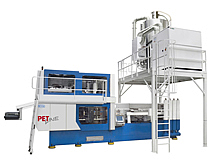If preform manufacturers invest in a new production system, then not only the investment volume and the services provided are of enormous importance. On the contrary, the efficiency and energy consumption of the system are also major factors.
| Netstal-Maschinen AG meets all user requirements with the established PET-LINE product line. With its flexible platform strategy, Netstal has successfully realised the continuous development of higher cavity numbers on smaller system sizes, shorter cycle times and increased plasticizing performance. And as a result, it sets standards for the efficient production of preforms. The three PET-LINE system sizes 2000, 3500 and 6000 kN for mould sizes from 24 to 192 cavities offer the right solution for any requirements – and that with maximum energy efficiency! |
To create an economically efficient production system and use the platform strategy in the best possible way, Netstal also makes no compromises of any kind when it comes to the machine details. The foundation for a first-class process is already laid during drying of the material. Assuming good drying, the focus is placed on the ideal energy input into the raw material. In the drying hopper the energy can be used especially efficiently to heat the material. The plasticizing unit requires a corresponding reduction in the processing power, which plasticises the material more gently and reduces the production of acetaldehyde.
With regard to energetics, the units of a production system should never be judged individually. On the contrary, the entire system must be closely examined for its mutual interaction. If PET granulate is heated from 0°C to 180°C, about 250 kJ/kg are absorbed. This is equivalent to 70 Wh/kg. The actual drying process requires an additional 3.5 Wh/kg. As a result, the physical energy requirement – which we cannot influence – is 73.5 Wh/kg. For an assumed dryer efficiency of 90%, the final energy requirement would be approximately 81 Wh/kg. Now if a material dryer is used with a consumption value considerably lower than that calculated in the preceding example, the missing energy must ultimately be compensated by the plasticizing unit. However, this performance can in turn not achieve that of a material dryer. |
|
Due to the higher consumption values, the material is damaged more heavily, which inevitably leads to higher acetaldehyde values on the finished product and simultaneously results in an additional energy loss.
With its optimised screw geometry, intelligent intrusion (continuous screw rotation) and electric drive, the plasticizing unit of a PET-LINE is the most efficient solution available on the market today. In combination with an exactly designed material dryer, the plasticizing unit can – depending on the load range – achieve an overall efficiency considerably above 80%. The homogenisation required for a good melt quality has already been taken into account here.
Maximum efficiency with the PET-LINE Platform 2000
The clamping unit based on toggle levers not only helps to save energy, it also results in top performance. In cooperation with mould suppliers, Netstal has succeeded in realising maximum numbers of cavities on production systems with minimal clamping forces. Thanks to the extremely precise, low-maintenance clamping unit, this enables the outstanding productivity of a smaller machine to be used very elegantly.
Netstal already successfully showed 192 cavities on a PET-LINE Platform 6000 at the 2004 K Trade Fair in Düsseldorf, Germany. Three years later, at the 2007 K Trade Fair, this was followed by 128 cavities on a PET-LINE Platform 3500. At this year’s Drinktec in Munich, Netstal will now present its innovative PET-LINE Platform 2000 with 60 cavities. With this impressive presentation, Netstal once again proves that shorter cycle times need not be linked to increased energy consumption! In combination with a maximisation of the number of cavities, the solid shorter cycle times are the optimum way to achieve absolute efficiency. With 60 cavities, this 200 tonne production system offers an ejection capacity of an incomparable magnitude. In view of the energy consumption as well, this highly profitable production system can compete quite well with larger platforms of other suppliers. Netstal is also capable of calculating the energy requirements extremely accurately and absolutely reliably in advance depending on the product and the output. And this is a vital condition for a reliable calculation of manufacturing costs in today’s production planning!
But the PET-LINE production system also offers other advantages. Thanks to continuously running intrusion, we enable not only a reduction in the required energy, but also the processing of very sensitive raw materials. The processing of polylactides (PLA) or the use of various blends presents no problem whatsoever for the PET-LINE. The mixing of PET material with up to 10% polyamide to achieve a barrier effect deserves particular mention here. Especially when it comes to this application, gentle, specific plasticizing is an absolute necessity. Of course, this process is also available in conjunction with dye additives for a PET-LINE from Netstal without complexity of any kind.









